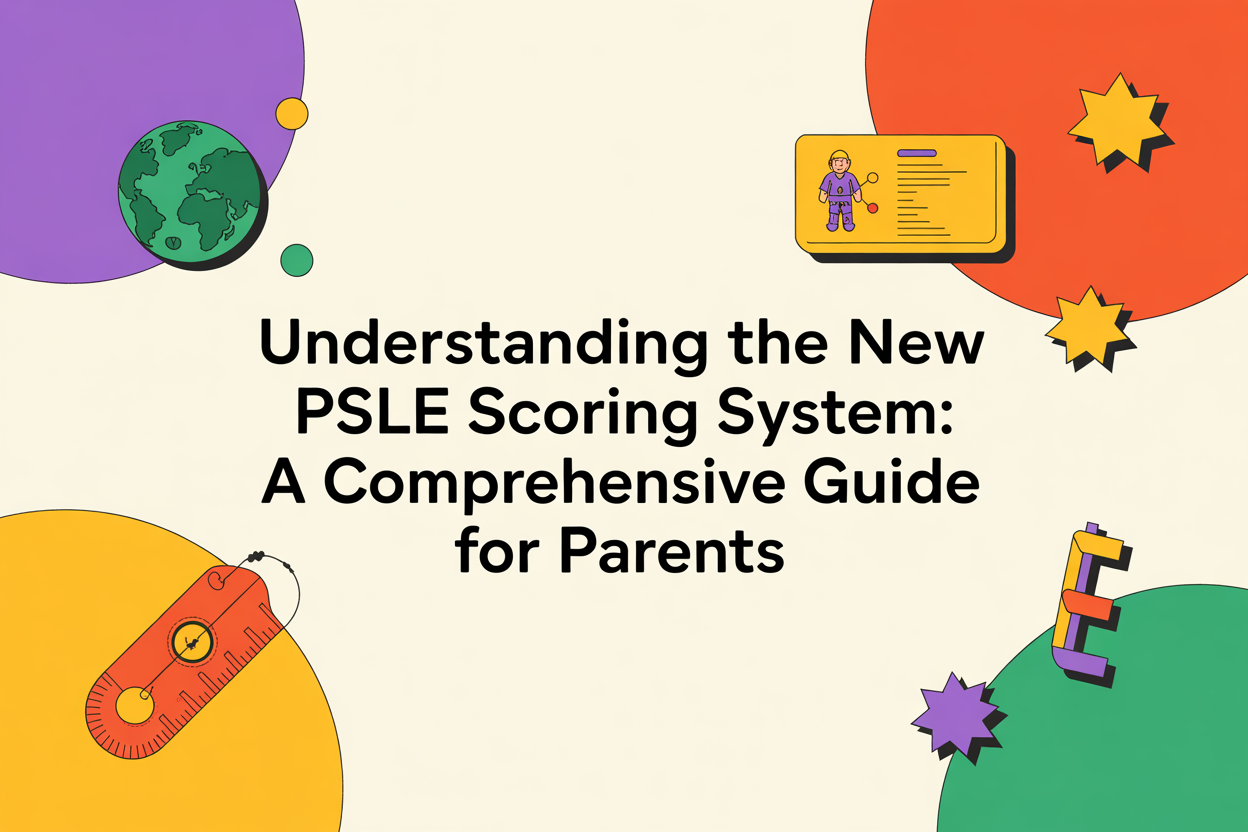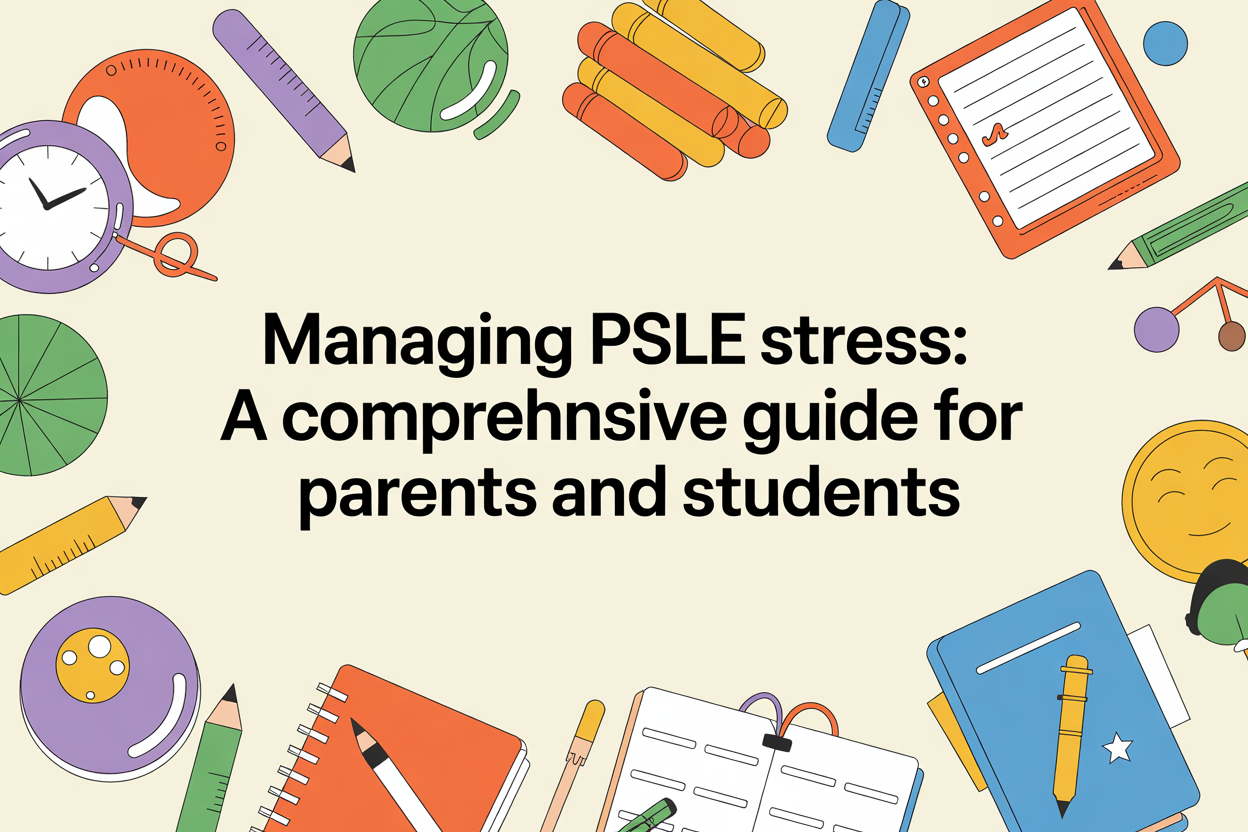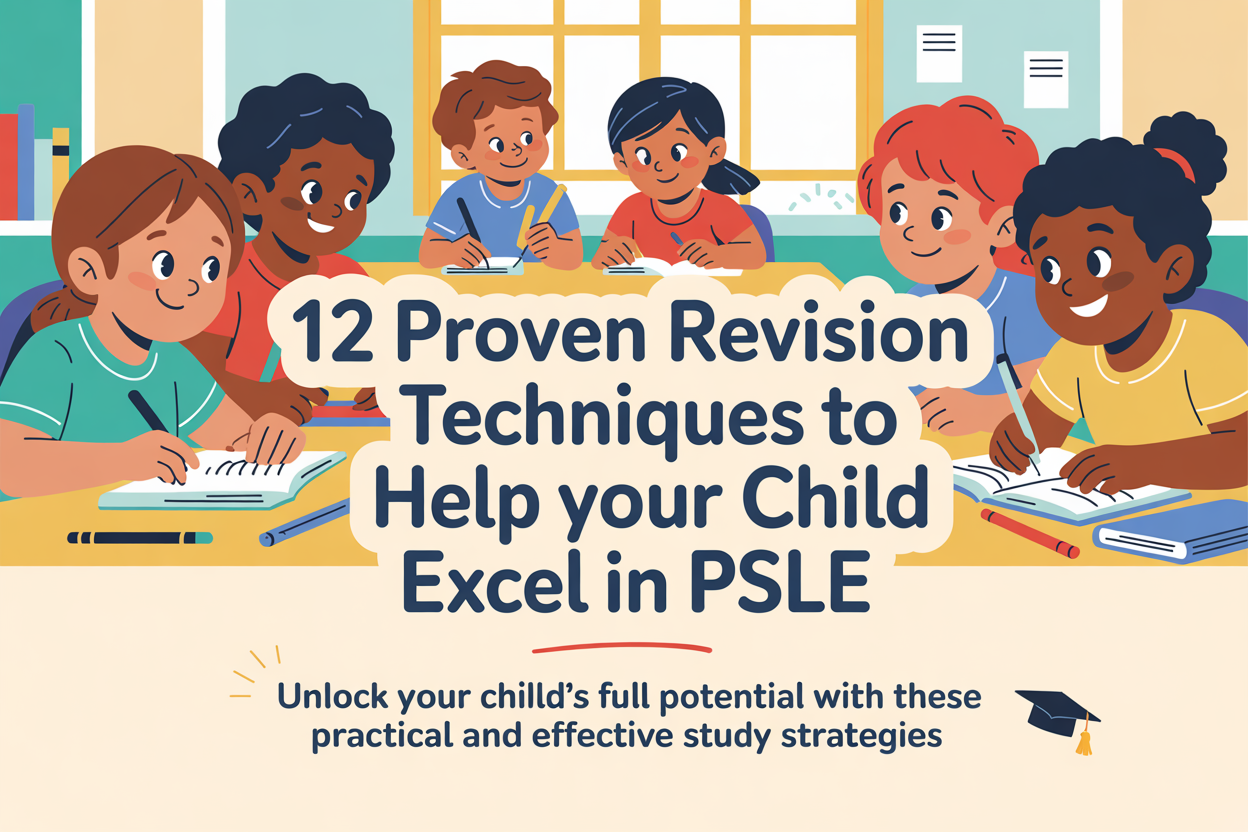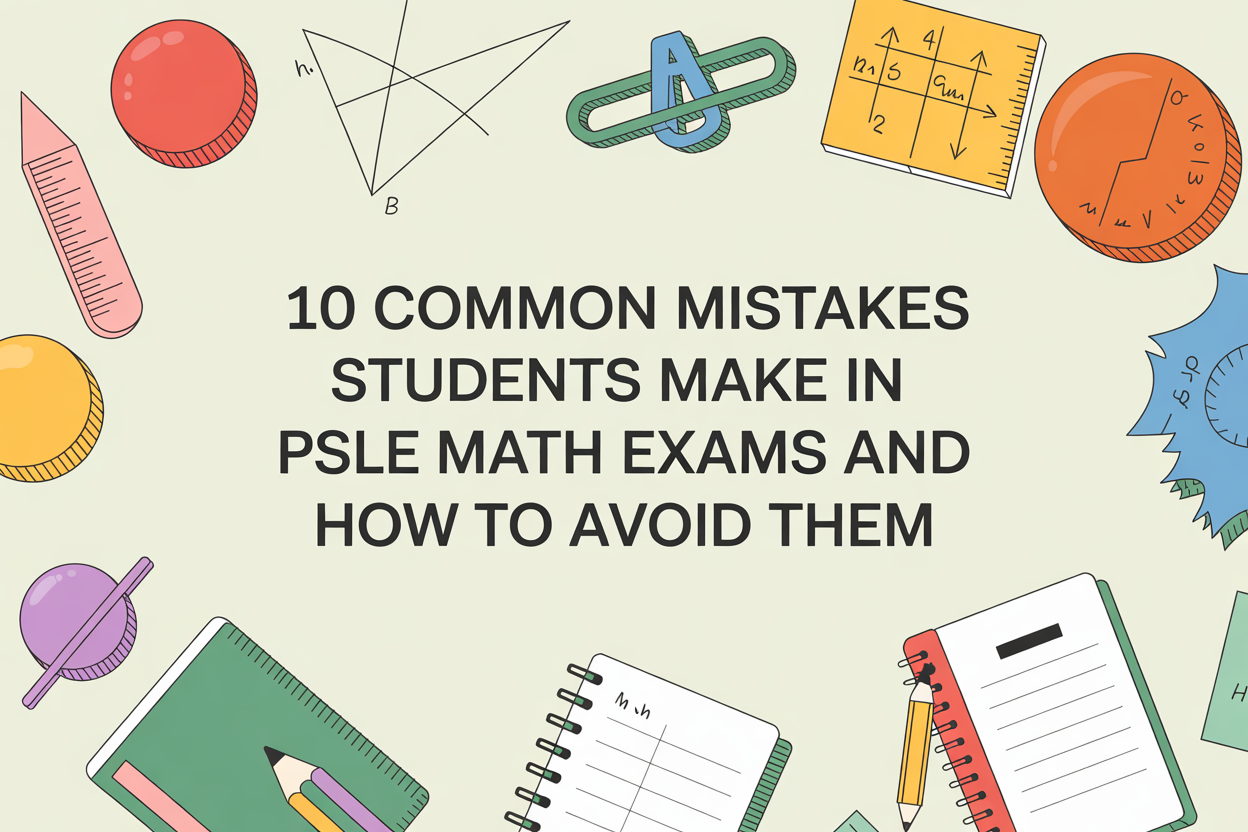- May 7, 2025 -
Understanding the New PSLE Scoring System: A Comprehensive Guide for Parents

Table of Contents:
- Evolution of the PSLE Scoring System
- Understanding the Current AL-Based Scoring System
- How Achievement Levels (ALs) Work
- Calculating the PSLE Score
- Subject-Specific Scoring Considerations
- How the New System Impacts Secondary School Admission
- Changes to Look for in 2025
- How to Help Your Child Prepare Under the New System
- Common Questions About the PSLE Scoring System
As a parent of a child approaching the Primary School Leaving Examination (PSLE), you’ve likely heard about the significant changes to the scoring system implemented in recent years. With more adjustments potentially on the horizon for 2025, understanding how your child will be evaluated is crucial for providing them with the right support and guidance.
The PSLE remains a pivotal milestone in Singapore’s education journey, serving as a checkpoint that determines your child’s secondary school placement and academic pathway. However, the way performance is measured has evolved substantially from the comparative T-score system of the past to today’s Achievement Levels (AL) approach.
In this comprehensive guide, we’ll walk you through everything you need to know about the current PSLE scoring system, potential changes for 2025, and practical strategies to help your child navigate this important examination with confidence. Our goal is to demystify the PSLE scoring framework so you can focus on what truly matters—supporting your child’s learning journey and development.
Evolution of the PSLE Scoring System
The Primary School Leaving Examination has been a cornerstone of Singapore’s education system since 1960. For decades, the PSLE employed the T-score (Transformed Score) system, which placed students on a bell curve and emphasized how they performed relative to their peers.
Under the previous T-score system, students received aggregate scores that could range from 0 to 300, with most students scoring between 150 and 290. This system was inherently competitive, as it ranked students against one another rather than measuring their absolute performance or mastery of subjects.
In 2016, the Ministry of Education (MOE) announced a significant shift away from this comparative approach. After several years of preparation, 2021 marked the implementation of the Achievement Levels (AL) scoring system—a change designed to reduce excessive competition and refocus education on learning rather than comparing.
This transformation reflected a broader philosophical shift in Singapore’s education approach: moving from an emphasis on academic ranking toward recognizing students’ individual strengths and achievements. The new system aims to nurture a love for learning rather than fostering unhealthy competition, while still maintaining standards of academic excellence that Singapore is known for.
Understanding the Current AL-Based Scoring System
The Achievement Level (AL) system introduced in 2021 represents a fundamental shift in how student performance is measured. Rather than comparing students against their peers, the AL system measures each student’s level of achievement in absolute terms against learning objectives.
In this system, students receive AL scores ranging from 1 to 8 for each subject, with AL1 representing the highest level of achievement and AL8 the lowest. The final PSLE score is simply the sum of the four AL scores (English Language, Mathematics, Science, and Mother Tongue Language), resulting in a possible score range of 4 to 32, where lower scores indicate better performance.
This band-based approach offers several advantages over the previous T-score system:
First, it reduces fine differentiation between students. Under the previous system, students could be separated by just one or two points out of 300, creating unnecessary stress and competition. The AL bands group students with similar levels of achievement together, acknowledging that small differences in raw marks may not meaningfully reflect different levels of mastery.
Second, it provides clearer information about a student’s actual level of subject mastery. A score of AL1 or AL2 directly indicates excellent understanding of the subject, regardless of how other students performed.
Third, it encourages a focus on learning and improvement rather than outperforming peers. Students can work toward achieving better ALs in their subjects without worrying about how their classmates are performing.
How Achievement Levels (ALs) Work
Understanding the specific Achievement Level bands is essential for interpreting your child’s performance and setting appropriate goals. Each AL corresponds to a specific range of raw marks:
AL1: ≥90 marks
AL2: 85-89 marks
AL3: 80-84 marks
AL4: 75-79 marks
AL5: 65-74 marks
AL6: 45-64 marks
AL7: 20-44 marks
AL8: <20 marks
Let’s illustrate with an example: If your child scores 92 marks in Mathematics, 81 marks in Science, 76 marks in English, and 66 marks in Mother Tongue, their AL scores would be:
Mathematics: AL1 (≥90 marks)
Science: AL3 (80-84 marks)
English: AL4 (75-79 marks)
Mother Tongue: AL5 (65-74 marks)
This gives them a total PSLE Score of 1 + 3 + 4 + 5 = 13.
The new system makes it easier to understand precisely where improvement is needed. For instance, if your child receives an AL5 in Science with a raw score of 65, they know they need to improve by at least 10 marks to reach the next band (AL4). This clarity helps in setting specific learning goals.
It’s worth noting that the AL bands are not evenly distributed. The bands for higher scores (AL1-AL4) are narrower (5-mark ranges) than those for middle performances (AL5 has a 10-mark range) and lower performances (AL6 has a 20-mark range). This design reflects the increasing difficulty of achieving distinction at higher levels of performance.
Calculating the PSLE Score
Calculating your child’s PSLE score under the AL system is straightforward. Here’s the step-by-step process:
Step 1: Convert the raw score for each subject to its corresponding AL (from 1 to 8)
Step 2: Add the ALs for all four subjects (English Language, Mathematics, Science, and Mother Tongue Language)
Step 3: The sum is your child’s PSLE Score, ranging from 4 (best possible) to 32 (lowest possible)
Let’s work through another example:
English Language: 87 marks → AL2
Mathematics: 92 marks → AL1
Science: 83 marks → AL3
Mother Tongue Language: 76 marks → AL4
PSLE Score = 2 + 1 + 3 + 4 = 10
A score of 10 would be considered excellent and would qualify a student for top secondary schools, though actual admission will depend on choice order and available spaces.
What constitutes a “good” PSLE score? While this depends somewhat on your child’s aspirations and preferred secondary schools, generally:
4-7: Exceptional performance, eligible for top schools including Integrated Programme schools
8-14: Excellent performance, eligible for most Express stream schools
15-22: Good performance, eligible for Express stream schools with moderate cut-off points
23-24: Borderline between Express and Normal (Academic) streams
25-30: Normal (Academic) stream
Above 30: Normal (Technical) stream
These ranges are approximate and can vary based on the competitiveness of a given year and the popularity of specific schools. The exact cut-off points for schools are published after each year’s posting exercise.
Subject-Specific Scoring Considerations
While the basic AL scoring framework applies across all subjects, there are some important subject-specific considerations to be aware of:
Standard vs. Foundation Subjects
Some students take Foundation level subjects, which are designed to build basic understanding and confidence. For Foundation subjects, the AL scoring works differently:
Foundation AL A: 75-100 marks (equivalent to Standard level AL6)
Foundation AL B: 30-74 marks (equivalent to Standard level AL7)
Foundation AL C: Below 30 marks (equivalent to Standard level AL8)
This means that a student who performs exceptionally well in a Foundation subject (scoring an A) will receive an AL6 for that subject in their PSLE Score calculation.
Higher Mother Tongue
Higher Mother Tongue Language (HMTL) is offered to students who demonstrate strong ability in their Mother Tongue. While the HMTL result is not counted in the main PSLE Score calculation, it can provide an advantage during secondary school posting in cases where students have the same PSLE Score.
A pass in HMTL (Distinction, Merit, or Pass) gives a student priority over one without HMTL in tie-breaker situations. Additionally, students who take HMTL at the PSLE are eligible to pursue HMTL in secondary school, which can be beneficial for those planning to enter the Integrated Programme or junior colleges later.
Exemptions and Special Cases
Some students may be exempted from certain subjects due to learning differences or special circumstances. In such cases, the PSLE Score is calculated based on the remaining subjects, with appropriate scaling to ensure fairness.
For students exempted from Mother Tongue Language, their PSLE Score will be derived by first computing the average of the ALs for English Language, Mathematics, and Science. This average value, rounded to the nearest whole number, will be used in place of the Mother Tongue Language AL.
Students with additional accommodations, such as extra time or assistive technology, are scored using the same AL bands as other students once their examinations are completed.
How the New System Impacts Secondary School Admission
The AL-based PSLE scoring system has significant implications for secondary school posting. Under this system, secondary schools still maintain cut-off points, but these are now expressed in terms of AL scores rather than T-scores.
The secondary school posting process follows these key steps:
Step 1: Students receive their PSLE results and AL scores
Step 2: Students select up to 6 secondary schools in order of preference
Step 3: Students are posted to schools based on:
– Their PSLE Score (lower scores get higher priority)
– Their school choices (in the order listed)
– Citizenship status (Singapore citizens get priority, followed by permanent residents, then international students)
– Tie-breakers when necessary (computerized balloting)
The choice order has become increasingly important under the new system. Because the AL bands group more students together with the same score, there are more instances where students with identical PSLE Scores are applying to the same school. In such cases, choice order becomes the deciding factor—a student who places a school as their first choice will have priority over one who places it as their second or third choice, even if both have the same PSLE Score.
If there are still ties after considering choice order and citizenship, computerized balloting will be used as the final tie-breaker. This means an element of chance is introduced when all other factors are equal.
For parents and students, this system emphasizes the importance of making realistic and well-informed school choices. It’s advisable to include a mix of schools—some aspirational choices and some safer options—to ensure your child secures a place in a suitable school.
At EduFirst Learning Centre, we regularly counsel parents on school selection strategies based on their child’s performance and aspirations, helping to optimize the balance between ambition and practicality.
Changes to Look for in 2025
While the Ministry of Education has not announced major structural changes to the PSLE scoring system for 2025, there are several refinements and ongoing developments that parents should be aware of:
Curriculum Updates
The MOE continually reviews and updates subject syllabi to ensure they remain relevant. By 2025, we may see subtle shifts in examination content to reflect evolving educational priorities, particularly in areas like critical thinking, applied learning, and digital literacy.
Assessment Format Refinements
Based on feedback and performance data from the first few years of the AL system, MOE might introduce refinements to assessment formats or question types. These are unlikely to change the scoring system itself but could affect how students approach exam preparation.
Greater Emphasis on Applied Learning
In line with Singapore’s broader educational direction, we anticipate a continued shift toward applied learning and real-world problem-solving in PSLE assessments. This means questions that test conceptual understanding rather than mere memorization and recall.
Potential Cut-off Point Adjustments
As more data becomes available about student performance under the AL system, secondary schools may adjust their cut-off points. Parents should stay informed about these trends when considering school options.
Holistic Development Focus
The MOE continues to emphasize that the PSLE is just one aspect of a child’s educational journey. By 2025, we may see enhanced mechanisms to recognize students’ strengths in non-academic areas during the secondary school posting process, though the PSLE Score will remain the primary sorting mechanism.
To stay updated on any announced changes, we recommend regularly checking the MOE website and attending parent briefings organized by your child’s primary school. At EduFirst, we also keep our curriculum aligned with the latest MOE guidelines and assessment directions, ensuring our students are well-prepared for any evolving requirements.
How to Help Your Child Prepare Under the New System
Preparing for the PSLE under the AL-based scoring system requires a strategic approach that emphasizes mastery over competition. Here are effective strategies to help your child succeed:
Focus on Subject Mastery, Not Comparison
The AL system rewards thorough understanding of concepts rather than marginal advantages over peers. Encourage your child to aim for complete mastery of each topic before moving on. Deep understanding is more valuable than covering many topics superficially.
Target Specific AL Bands
Help your child set realistic goals in terms of AL bands. If they’re consistently scoring in the AL4 range (75-79%) in practice tests, focus efforts on securing those few additional marks needed to reach AL3 (80-84%). This targeted approach is more efficient than a general directive to “do better.”
Balance Across Subjects
Since the PSLE Score is simply the sum of four subject ALs, an improvement in any subject contributes equally to the final score. This means allocating more study time to subjects where improvement is most achievable. For instance, moving from AL6 to AL5 in a weaker subject may be more attainable than moving from AL2 to AL1 in a stronger subject, though both improvements would reduce the PSLE Score by the same amount.
Practice with AL-Aligned Assessments
Ensure that practice materials and mock examinations your child uses are aligned with current PSLE standards. At EduFirst Learning Centre, our assessment materials are continuously updated to reflect the latest examination formats and difficulty levels.
Develop Strong Fundamentals
The AL system’s banded approach means that careless mistakes can be particularly costly if they drop a student from one band to another. Focus on building strong fundamentals and practicing careful work habits rather than rushing through problems.
Manage Examination Stress
Help your child develop strategies for managing examination stress and anxiety. Techniques like deep breathing, proper time management during the exam, and having a consistent pre-exam routine can improve performance significantly.
Preparation Timeline
Ideally, serious PSLE preparation should begin in Primary 5, with a structured revision plan intensifying in Primary 6. A typical timeline might look like:
Primary 5: Build strong foundations in all subjects, identify and address knowledge gaps
Primary 6 (January-March): Complete coverage of the syllabus, regular practice with time constraints
Primary 6 (April-June): Focused revision of challenging topics, practice with past-year papers
Primary 6 (July-August): Mock examinations, refinement of exam techniques
Primary 6 (September): Light revision, maintaining confidence and well-being
At EduFirst, our small class sizes of 4-8 students allow for personalized attention that helps identify exactly where each child needs support in their PSLE preparation journey.
Common Questions About the PSLE Scoring System
Is it harder to score well under the AL system compared to the old T-score system?
Not necessarily. The AL system removes the relative comparison aspect, so students are no longer competing directly against their peers. A student who masters the curriculum can achieve excellent AL scores regardless of how others perform. However, with more students potentially achieving the same PSLE Score, competition for popular schools may remain intense.
How important is the choice order in secondary school posting?
Choice order has become significantly more important under the AL system. With more students achieving identical PSLE Scores, choice order frequently serves as the tie-breaker. A school listed as first choice will always take precedence over the same school listed as a second or subsequent choice for students with the same score.
What happens if my child is between streams?
Students with PSLE Scores at the borderline between streams (typically around 22-24 for Express/Normal (Academic)) may be offered options. Some schools provide hybrid options where students take some subjects at Express level and others at Normal (Academic) level, with the possibility of moving fully to Express stream if they perform well.
Should my child take Higher Mother Tongue?
Higher Mother Tongue can provide an advantage in tie-breaking situations during secondary school posting. It’s suitable for students who have a strong foundation in their Mother Tongue and can handle the additional academic load without compromising performance in other subjects.
How does the Direct School Admission (DSA) work with the AL system?
The DSA pathway allows students to secure a place in a secondary school based on their talents and achievements before receiving their PSLE results. Students admitted through DSA are still required to take the PSLE and must qualify for Express, Normal (Academic), or Normal (Technical) stream as appropriate for their chosen school.
What if my child has learning needs or requires exam accommodations?
MOE provides various accommodations for students with documented learning needs, including extra time, separate examination rooms, or assistive technologies. These accommodations ensure fair access to the examination but do not change the scoring system itself.
Conclusion
The transition to the Achievement Level (AL) scoring system for PSLE represents a significant shift in Singapore’s educational philosophy—moving from comparison to mastery, from competition to learning. By understanding how this system works and what it values, you can better support your child through this important milestone.
Remember that while the PSLE is an important checkpoint, it’s just one part of your child’s educational journey. The skills they develop along the way—critical thinking, problem-solving, resilience, and a love for learning—will serve them well regardless of their eventual PSLE Score.
As we look toward potential refinements to the system in 2025 and beyond, the fundamental principles are likely to remain consistent: recognizing individual achievement, reducing unhealthy competition, and ensuring students are appropriately placed for the next phase of their education.
At EduFirst Learning Centre, we’re committed to helping students navigate the PSLE with confidence through our personalized approach to education. Our small class sizes of 4-8 students ensure that each child receives the individual attention they need to understand concepts thoroughly and develop effective examination strategies.
Want to learn more about how EduFirst can help your child prepare for the PSLE? Our experienced teachers and carefully designed curriculum have helped thousands of students achieve their potential.
Contact us today to schedule a consultation or learn more about our PSLE preparation programs across our 25 centers islandwide.



